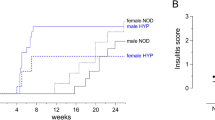Abstract
Insulin-dependent diabetes of man, the BB rat and the NOD mouse appears to result from autoimmune β cell destruction in a setting of genetic predisposition. The NOD mouse develops insulin-dependent diabetes secondary to islet β cell destruction by infiltrating lymphoid cells (insulitis), resulting in lack of intrinsic insulin secretion, hyperglycemia, loss of body weight and ketosis as seen in human insulin-dependent diabetes (Makino S, et al. 1980). Insulitis appears as early as 5 weeks of age. The lymphoid cells invade islets and are often seen adjacent to the ducts and blood vessels (Figure 1). The inceidence of insulitis is 90% in NOD females and 70% in NOD males at 9 weeks of age. The incidence and degree of insulitis increase with age. The NOD mouse develops diabetes usually by 6 months of age. The cumulative incidence of diabetes in our NOD/ShiJos colony is 80% in NOD females and less than 20% in NOD males at 7 months of age. In some other colonies, the incidence of diabetes in males is higher (approximately 50%) than that in our NOD/ShiJos colony (Prochazka M, et al. 1987). This could be due to differences in diets, environments and NOD-lines.
Access this chapter
Tax calculation will be finalised at checkout
Purchases are for personal use only
Preview
Unable to display preview. Download preview PDF.
Similar content being viewed by others
Literature Cited
Acha-Orbea H, McDevitt HO (1987) The first external domain of the non-obese diabetic mouse class II I-Aβ chain is unique. Proc Natl Acad Sci USA 84: 2435–2439
Hattori M, Buse JB, Jackson RA, Glimcher L, Dorf ME, Minami M, Makino S, Moriwaki K, Kuzuya H, Imura H, Strauss WM, Seidman JG, Eisenbarth GS (1986) The NOD mouse: recessive diabetogenic gene in the major histocompatibility complex. Science 231: 733–735
Ikegami H, Jackson RA, Makino S, Watts DE, Eisenbarth GS, Hattori M (1986) Homozygosity for two genes (H-2:chromosome 17 and Thy-1: chromosome 9) linked to the development of Type I diabetes of the NOD mouse. Clin Res 34: 683A
Ikegami H, Makino S, Harada M, Eisenbarth GS, Hattori M (1988) The cataract Shionogi mouse, a sister strain of the non-obese diabetic mouse: similar class II but different class I gene products. Diabetologia 31: 254–258
Katoh H (1988) MHC genes of inbred strains derived from outbred ICR mice. In:Yoshida T (ed) Annual Report 1987 by the Research Committee of Experimental Models for Intractable Diseases. The Ministry of Health and Welfare of Japan, Tokyo, p139
Makino S, Kunimoto K, Muraoka Y, Mizushima Y, Katagiri K, Tochino Y (1980) Breeding of a non-obese, diabetic strain of mice. Exp Anim 29: 1–13
Makino S, Kunimoto K, Muraoka Y, Katagiri K (1981) Effect of castration on the appearance of diabetes in NOD mice. Exp Anim 30: 137–140
Nishimoto H, Kikutani K, Yamamura K, Kishimoto T (1987) Prevention of autoimmune insulitis by expression of I-E molecules in NOD mice. Nature 328: 432–434
Prochazka M, Leiter ED, Serreze DV, Coleman DG (1987) Three recessive loci required for insulin-dependent diabetes in nonobese diabetic mice. Science 237: 286–289
Scott FW, Mongeau R, Kardish M, Hatina G, Trick KD, Wojcinski Z (1985) Diet can prevent diabetes in the BB rat. Diabetes 34: 1059–1062
Wicker LS, Miller BJ, Cocker LZ, McNally SE, Scott S, Mullen Y, Appel MC (1987) Genetic control of diabetes and insulitis in the nonobese diabetic ( NOD) mouse. J Exp Med 165: 1639–1654
Yoon JW, Austin M, Onodera T, Notkins AL (1979) Virus induced diabetes. Isolation of a virus from the pancreas of a child with diabetic ketoacidosis. N Engl J Med 300: 1173–1179
Author information
Authors and Affiliations
Editor information
Editors and Affiliations
Rights and permissions
Copyright information
© 1990 Springer-Verlag Berlin Heidelberg
About this paper
Cite this paper
Hattori, M., Fukuda, M., Horio, F. (1990). A Single Recessive Non-MHC Diabetogenic Gene Determines the Development of Insulitis in NOD Mice. In: Demaine, A.G., Banga, JP., McGregor, A.M. (eds) The Molecular Biology of Autoimmune Disease. NATO ASI Series, vol 38. Springer, Berlin, Heidelberg. https://doi.org/10.1007/978-3-642-75133-2_25
Download citation
DOI: https://doi.org/10.1007/978-3-642-75133-2_25
Publisher Name: Springer, Berlin, Heidelberg
Print ISBN: 978-3-642-75135-6
Online ISBN: 978-3-642-75133-2
eBook Packages: Springer Book Archive




